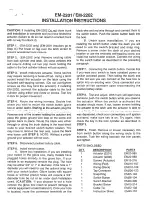
yellow
blue
4-29
Loading Your Vehicle
The GVW/Tire Information label is found on the rear
edge of the driver’s door. The label shows the size of
your original tires and the inflation pressures needed to
obtain the gross weight capacity of your vehicle.
This is called the Gross Vehicle Weight Rating
(GVWR). The GVWR includes the weight of the
vehicle, all occupants, fuel and cargo.
The Certification/Tire label is provided by the final
manufacturer and should be on the door or door jamb. It
also tells you the maximum weights for the front and rear
axles, called Gross Axle Weight Rating (GAWR). To find
out the actual loads on your front and rear axles, you need
to go to a weigh station and weigh your vehicle. Your
dealer can help you with this. Be sure to spread out your
load equally on both sides of the centerline.
Never exceed the GVWR for your vehicle, or the
GAWR for either the front or rear axle.
And, if you do have a heavy load, you should spread
it out.
CAUTION:
Do not load your vehicle any heavier than the
GVWR, or either the maximum front or rear
GAWR. If you do, parts on your vehicle can
break, and it can change the way your vehicle
handles. These could cause you to lose control
and crash. Also, overloading can shorten the life
of your vehicle.
Summary of Contents for T-Series 1999
Page 28: ...yellowblue 1 22...
Page 84: ...yellowblue 2 48 Instrument Panel...
Page 115: ...yellowblue 3 13 NOTES...
Page 116: ...yellowblue 3 14 NOTES...
Page 148: ...yellowblue 4 32 NOTES...
Page 184: ...yellowblue 5 36 NOTES...
Page 185: ...yellowblue 5 37 NOTES...
Page 186: ...yellowblue 5 38 NOTES...
Page 262: ...yellowblue 6 76 NOTES...
Page 324: ...yellowblue 7 62 Maintenance Record DATE ODOMETER READING SERVICED BY MAINTENANCE PERFORMED...
Page 334: ...yellowblue 8 10 NOTES...
















































